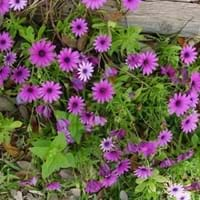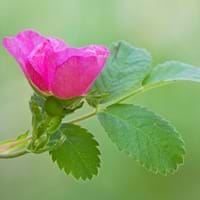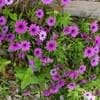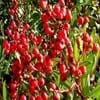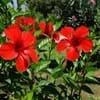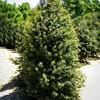Life Span
Perennial
Perennial
Type
Perennial
Flowering Plants, Ornamental Plant, Perennial
Origin
Hybrid origin, South Africa
California, Caribbean, Mexico
Types
Not Available
Not Available
Habitat
gardens
Chaparral, Foot Hills, Woodlands
USDA Hardiness Zone
10-11
Not Available
AHS Heat Zone
6-1
Not Available
Sunset Zone
8, 9, 12, 13, 14, 15, 16, 17, 18, 19, 20, 21, 22, 23, 24
Not available
Habit
Clump-Forming
Upright/Erect
Flower Color
Light Purple, Purple
Variety of colors
Flower Color Modifier
Bicolor
Bicolor
Fruit Color
Not Available
Non Fruiting Plant
Leaf Color in Spring
Green, Blue Green
Gray, Gray Green
Leaf Color in Summer
Green, Blue Green
Gray, Gray Green
Leaf Color in Fall
Green, Blue Green
Gray, Gray Green
Leaf Color in Winter
Gray Green, Silver
Gray, Gray Green
Leaf Shape
Elliptic, toothed
Pinnate
Plant Season
Spring, Summer, Fall
Spring, Summer, Fall
Sunlight
Full Sun
Full Sun, Partial Sun
Type of Soil
Loam
Loam, Sand
The pH of Soil
Neutral
Acidic, Neutral
Soil Drainage
Well drained
Well drained
Bloom Time
Late Spring, Early Summer, Summer, Late Summer, Early Fall, Fall
Spring, Late Spring, Early Summer, Summer, Late Summer, Early Fall, Fall
Repeat Bloomer
Yes
Not Available
Tolerances
Drought, Salt
Drought
Where to Plant?
Container, Ground, Pot
Container, Ground, Pot
How to Plant?
Cuttings, Seedlings
Cuttings
Plant Maintenance
Medium
Medium
Watering Requirements
Requires regular watering
Average Water Needs
In Summer
Lots of watering
Lots of watering
In Spring
Moderate
Moderate
In Winter
Average Water
Average Water
Soil pH
Neutral
Acidic, Neutral
Soil Type
Loam
Loam, Sand
Soil Drainage Capacity
Well drained
Well drained
Sun Exposure
Full Sun
Full Sun, Partial Sun
Pruning
Remove damaged leaves, Remove dead branches, Remove dead leaves
Remove damaged leaves, Remove dead branches, Remove dead leaves
Fertilizers
All-Purpose Liquid Fertilizer
All-Purpose Liquid Fertilizer
Pests and Diseases
Aphids, Caterpillars, Root rot, Spider mites, Stem rot, Whiteflies
Beetles, Black Spot, Caterpillars, Downy mildew, Mosaic viruses, Powdery mildew, Rust, Scale insects, Thripes
Plant Tolerance
Drought
Drought
Flower Petal Number
Single
Double
Edible Fruit
No
Not Available
Foliage Texture
Medium
Medium
Foliage Sheen
Glossy
Glossy
Invasive
No
Not Available
Self-Sowing
No
Not Available
Attracts
Bees, Butterflies, Insects
Birds, Butterflies
Allergy
Not Available
Rash
Aesthetic Uses
Showy Purposes
Showy Purposes
Beauty Benefits
Not Available
Not Available
Environmental Uses
Air purification
Air purification
Medicinal Uses
Not Available
Not Available
Part of Plant Used
Flowers
Flowers
Other Uses
Air freshner, Oil is used in perfume, soaps, creams, etc., useful as a ground cover
Oil is used in perfume, soaps, creams, etc.
Used As Indoor Plant
Yes
Yes
Used As Outdoor Plant
Yes
Yes
Garden Design
Bedding Plant, Container, Cutflower, Groundcover, Hanging Basket, Mixed Border, Rock Garden, Wall
Container, Cutflower, Feature Plant, Foundation, Mixed Border, Topiary / Bonsai / Espalier
Botanical Name
OSTEOSPERMUM 'Aksullo'
Rosa californica
Common Name
African daisy, Blue-eyed daisy
California wildrose, California rose
In Hindi
Cape Daisy
कैलिफोर्निया गुलाब
In German
Cape Daisy
Kalifornische Hecken-Rose
In French
Cape Daisy
Le rosier de Californie
In Spanish
Margarita del Cabo
Rosa californica
In Greek
Cape Daisy
Καλιφόρνια αυξήθηκε
In Portuguese
Cape Daisy
California aumentou
In Polish
Cape Daisy
California róży
In Latin
Cape Daisy
California resurrexit
Phylum
Magnoliophyta
Magnoliophyta
Class
Magnoliopsida
Magnoliopsida
Family
Asteraceae
Rosaceae
Clade
Angiosperms, Asterids, Eudicots
Not Available
Tribe
Calenduleae
Not Available
Subfamily
Asteroideae
Not Available
Number of Species
Not Available
Season and Care of Cape Daisy and California Rose
Season and care of Cape Daisy and California Rose is important to know. While considering everything about Cape Daisy and California Rose Care, growing season is an essential factor. Cape Daisy season is Spring, Summer and Fall and California Rose season is Spring, Summer and Fall. The type of soil for Cape Daisy is Loam and for California Rose is Loam, Sand while the PH of soil for Cape Daisy is Neutral and for California Rose is Acidic, Neutral.
Cape Daisy and California Rose Physical Information
Cape Daisy and California Rose physical information is very important for comparison. Cape Daisy height is 20.30 cm and width 20.30 cm whereas California Rose height is 150.00 cm and width 150.00 cm. The color specification of Cape Daisy and California Rose are as follows:
Cape Daisy flower color: Light Purple and Purple
Cape Daisy leaf color: Green and Blue Green
California Rose flower color: Variety of colors
- California Rose leaf color: Gray and Gray Green
Care of Cape Daisy and California Rose
Care of Cape Daisy and California Rose include pruning, fertilizers, watering etc. Cape Daisy pruning is done Remove damaged leaves, Remove dead branches and Remove dead leaves and California Rose pruning is done Remove damaged leaves, Remove dead branches and Remove dead leaves. In summer Cape Daisy needs Lots of watering and in winter, it needs Average Water. Whereas, in summer California Rose needs Lots of watering and in winter, it needs Average Water.
